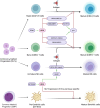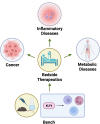Krüppel-like factor 4 control of immune cell function
- PMID: 40831570
- PMCID: PMC12358479
- DOI: 10.3389/fimmu.2025.1597210
Krüppel-like factor 4 control of immune cell function
Abstract
Krüppel-like factor 4 (KLF4) belongs to a family of transcription factors that contain conserved zinc finger DNA binding domains, including specificity proteins (SPs) and Krüppel-like factors (KLFs). KLF4 plays a vital role in regulating cellular differentiation, proliferation and adaptation to a broad spectrum of internal and external cues. In the context of the immunity, KLF4 is appreciated as critical to both the innate and adaptive arms of the immune system. The current review article focuses on these aspects of KLF4 action as well as implications of this work for impacting human health.
Keywords: KLF4; SP family; homeostasis; immune cells; innate & adaptive immune response.
Copyright © 2025 Das, Wang, Xu, Yang, Liao and Jain.
Conflict of interest statement
The authors declare that the research was conducted in the absence of any commercial or financial relationships that could be construed as a potential conflict of interest.
Figures





Similar articles
-
Alternative splicing of KLF4 in myeloid cells: implications for cellular plasticity and trained immunity in cancer and inflammatory disease.Front Immunol. 2025 Jun 9;16:1585528. doi: 10.3389/fimmu.2025.1585528. eCollection 2025. Front Immunol. 2025. PMID: 40552304 Free PMC article. Review.
-
KLF feedback loops in innate immunity.Front Immunol. 2025 Jun 4;16:1606277. doi: 10.3389/fimmu.2025.1606277. eCollection 2025. Front Immunol. 2025. PMID: 40534851 Free PMC article. Review.
-
Variants in KLF4 affecting residue Asp441 cause an autosomal dominant syndromic ichthyosis.Br J Dermatol. 2025 Jun 20;193(1):136-146. doi: 10.1093/bjd/ljaf062. Br J Dermatol. 2025. PMID: 39969530
-
The reprogramming factor KLF4 in normal and malignant blood cells.Front Immunol. 2025 Jun 16;16:1584181. doi: 10.3389/fimmu.2025.1584181. eCollection 2025. Front Immunol. 2025. PMID: 40589762 Free PMC article. Review.
-
Modulating Colorectal Cancer Cell Propagation and Immune Evasion by miRNA-148a-3p via KLF4.Iran J Allergy Asthma Immunol. 2025 Jun 26;24(4):481-497. Iran J Allergy Asthma Immunol. 2025. PMID: 40696734
References
Publication types
MeSH terms
Substances
LinkOut - more resources
Full Text Sources

